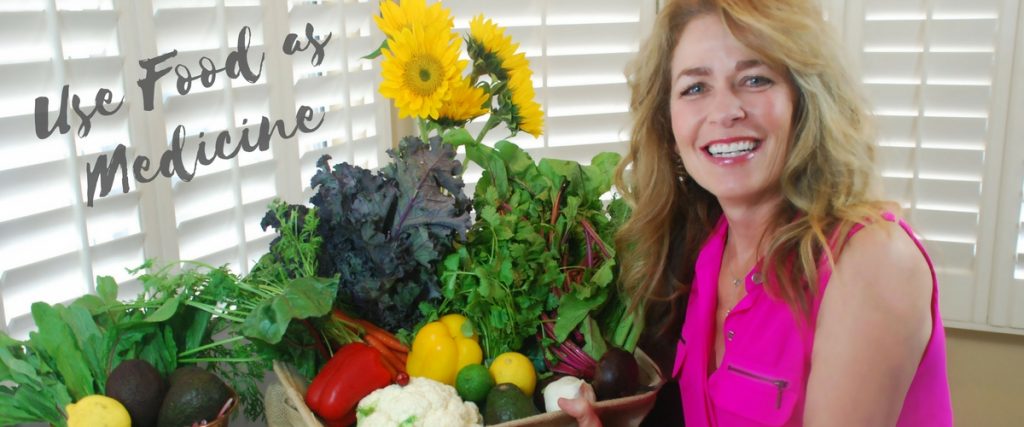Educating and Empowering You to Heal, Thrive, and Live a Happy, Healthy Lifestyle
12 “Real Food” Grocery Shopping Tips

“Let food be your medicine and medicine be your food.” – Hippocrates
Good nutrition, looking, feeling and functioning your best, and healthy eating begins by making smarter choices when you’re shopping for food. Your personal Fat Loss Revolution lifestyle starts in your kitchen! Go through your kitchen and have a food funeral. Get rid of the temptation items that don’t support your healthy lifestyle. Remember, food is medicine or food is poison… and, you get to choose.
12 “Real Food” Grocery Shopping Tips
Real Food Grocery Shopping Tip #1: Shop for nutrient-dense real food. Stay away from processed, boxed, dead frankenfoods, sodas, fruit juices and sugary beverages. Avoid fat-free and low-fat products that are loaded with chemicals, sugar and artificial sweeteners – a toxic burden on your body and detrimental to your mood, brain, body and waistline. Simply switching from processed food to more nutrient-dense real food is a huge step in the right direction to looking your best and feeling better than ever.
Real food is organic, nutrient-dense, anti-inflammatory, unprocessed, naturally-raised, grass-fed, pasture-raised, free-range, non-GMO.
Don’t be fooled while grocery shopping! Just because an item is low calorie, gluten-free, low-fat, non-fat or sugar-free does not mean it’s healthy. And, just because an item is high calorie or high fat does not mean it’s unhealthy. Food quality, nutrient-density, and the hormonal impact of food is what matters most. Become familiar with misleading marketing claims. Items labeled as “all-natural, organic, sugar-free or gluten-free” are not necessarily healthy.
Buyer Beware when Grocery Shopping!
Avoid these – they are not healthy foods
- Energy bars, snack bars, protein bars
- Diet soda pop, fruit juices, Crystal Light
- Agave syrup
- Dried fruit, fruit roll ups
- Veggie burgers
- Vitamin water, sport beverages
- Yogurt with fruit
- Cooking sprays, canola oil, margarine
- Cereal, granola, instant oatmeal, trail mixes
- Multi-grain bread, whole grain bread, wheat bread
- Soy milk and soy products
- Most gluten-free foods
- Some protein powders and some vitamins
- Low-fat and non-fat products
These items are nutritionally-void, a far cry from healthy real food, and most likely loaded with exorbitant amounts of sugar, rancid vegetable oils, corn, soy, wheat, genetically-modified ingredients, chemical preservatives, GMOs and artificial sweeteners that contribute to a blood sugar roller coaster, GI distress, increased cravings, depression, headaches, diabetes, memory and behavioral problems, leaky gut, dis-ease and extra body fat.
All processed foods contain at least one or more genetically modified ingredient and glyphosate!
If you eat processed foods, most of which are made with genetically-modified corn and soy, harmful chemicals and other toxic ingredients, you’re consuming glyphosate residues – no question!
Real Food Grocery Shopping Tip #2: Be a label detective. Read the list of ingredients on every product, including personal care items and pet food. Don’t buy any items that contain artificial ingredients, artificial sweeteners, chemicals, sucralose, canola oil, soybean oil and other vegetable oils, wheat, HFCS, colors and dyes. The fewer ingredients listed, the better.
When you see an item with a ‘QR code’ or ‘Smart Label’ on a food product, do not buy it. Products bearing the Grocery Manufacturer’s Association’s (GMA) Smart Label mark are most likely loaded with chemicals, pesticides and genetically-modified ingredients.
Look for one or more of these labels when grocery shopping
- USDA 100% Organic
- 100% grass-fed
- Non-GMO Verified
Real Food Grocery Shopping Tip #3: Shop with a list. Download the free Healthy Food Shopping Guide. Plan meals and snacks for the week.
Real Food Grocery Shopping Tip #4. Shop the organic section of the supermarket. If you’re on a budget, not every item you purchase has to be organic. Familiarize yourself with the Environmental Working Group’s (EWG) Dirty Dozen Plus and prioritize always buying these items organic.
When grocery shopping for fruits and veggies, you’ll notice a PLU code on the sticker that is usually four digits. The numbers on the sticker indicate if the item is genetically modified, conventional or organic. A fifth digit prefixed to the code indicates whether the fruit or vegetable is organic (prefixed by the numeral 9), or GM (prefixed by an 8).
Being able to recognize PLU codes can be helpful in your decision to purchase fruits and vegetables.
- Conventional – Grown with chemicals and pesticides. The PLU code consists of four numbers.
- GM – Genetically modified. The PLU code consists of five numbers beginning with the number 8.
- Organic – The five-digit PLU code begins with the number 9.
You’ll lower your pesticide exposure nearly 80% by choosing organic vs non-organic. There are many significant benefits to eating organic. Over 100 studies shows that organic produce provides 25% more nutrients than non-organic produce of the same varieties. Those who eat an organic diet tend to have a stronger immune systems, less body fat, calmer demeanor, more energy throughout the day, perform better, and experience more restful sleep patterns than those on a non-organic diet.
The vitamins and minerals in fruits and vegetables have declined up to 76% from 1940-1991.
In 1951, eating two peaches provided the daily requirement of vitamin A. Today, you would have to eat 53 peaches!!! The heavy use of chemical fertilizers, glyphosate, herbicides and pesticides have damaged the soil of vital nutrients and destroyed the healthy and necessary microbes that the plants need in order to absorb the minerals. This has caused many common fruits and veggies to contain significantly fewer vitamins and minerals today compared to 50-70 years ago.
A salad today (mixed greens, peppers, onions, tomato, olive oil) has from 15-76% less nutrient value, and is loaded with residues of pesticides and herbicides compared to the same salad mix in 1940.
While it may cost a bit more up front to eat organic foods, the long-term savings on medical care and your health are worth the investment. Not only that, when you eat nutrient-dense food, you tend not to consume as much food and you’ll feel fuller longer.
If you’re on a limited budget and can only afford certain items as organic, priority goes to organically-raised, grass-fed, free-range, pasture-raised butter, meats and eggs, and the Dirty Dozen veggies & fruits.
A study in the Journal of Environmental Research found that eating an organic diet for just one week can reduce damaging pesticide levels in adults nearly 90%!
Real Food Grocery Shopping Tip #5. Never go grocery shopping when you’re hungry or when you’re experiencing low blood sugar. Eat a protein-rich snack or handful of nuts before shopping. Stick to your list.
Real Food Grocery Shopping Tip #6. To save money, use coupons, keep an eye out for promotions and sales, and buy organic food in bulk.
- If you have the space and weather permitting, plant a garden to grow your own organic greens, sprouts, fruits and veggies.
- Be mindful while grocery shopping and take note of items you automatically purchase such as alcohol, candy bars, chips and the other items that are nutritionally-void and add up $$$ in the long run.
Real Food Grocery Shopping Tip #7. Stock up on seasonal and locally-grown veggies and fruits; they’re packed with nutrients, add diversity and variety to your diet, and seasonal items are often less expensive.
Real Food Grocery Shopping Tip #8. Most of us tend to eat the same foods over and over, day after day after day, and week after week. Be adventurous and buy one new veggie or leafy green to try every time you go grocery shopping. Experiment with healthier recipes that use real ingredients.
Real Food Grocery Shopping Tip #9. Shop at local farms and farmers markets or join a co-op for organic produce, meats and eggs. Sign up for home delivery of a local farm box. Order online.
- Visit the Local Harvest website to find farmers markets, family farms, and other sources of sustainably-grown food in your area.
- Order grass-fed, free-range meats, wild fish and seafood delivered to your home from U.S. Wellness Meats or Vital Choice Seafood.
- Join a food co-op such as Bountiful Baskets
- Join Chow Locally and the Chow Share program. You not only get healthy, fresh, ethically produced food at an affordable price, you support your local farmers and communities. Each week you’ll receive the best produce that Arizona farmers have to offer.
Real Food Grocery Shopping Tip #10. If you take the kiddos grocery shopping, use this time as an opportunity to educate them on healthier options and how to read ingredient labels. Show them the toxic ingredient list on chips, cookies, crackers, Cocoa Puffs, Cherrios, Fruity Pebbles, candies, juices, pudding cups, yogurts or other sugary treats.
Real Food Grocery Shopping Tip #11. Does your busy schedule prevent you from cooking or shopping?
- If you live near a Whole Foods Market, visit the seafood dept. and select your favorite fish. Ask them to cook it for you while you shop (a free service they offer).
- Order high-quality, grass-fed meats, free-range poultry and wild seafood online from U.S. Wellness Meats or Vital Choice Seafood.
Real Food Grocery Shopping Tip #12. Contrary to popular belief, eating healthy, nutrient-rich real food is not more expensive than processed, packaged foods or fast food. Buy the majority of your items from the perimeter of the store. Include plenty of fresh veggies and leafy greens; tubers such as parsnips, sweet potatoes and yams; seasonal fruit; pastured eggs and poultry, grass-fed butter, meats, wild fish and seafood. Minimize the items from the center aisles, except for organic coffee and tea, nuts and seeds, quinoa, coconut oil, olive oil, coconut or almond milk (carageenan-free only), nut butters, coconut flour and spices.
Eating healthy, nutrient-dense, organic real food is possible without spending more. Remember, you have complete control over what you buy and bring into your home. Choose wisely!
Related Articles
- Avoid these 12 Harmful Ingredients at all Costs
- Paula’s Real Food Pyramid
- GMO Health Hazards
- Video: Frightening… and Motivating Food Facts

